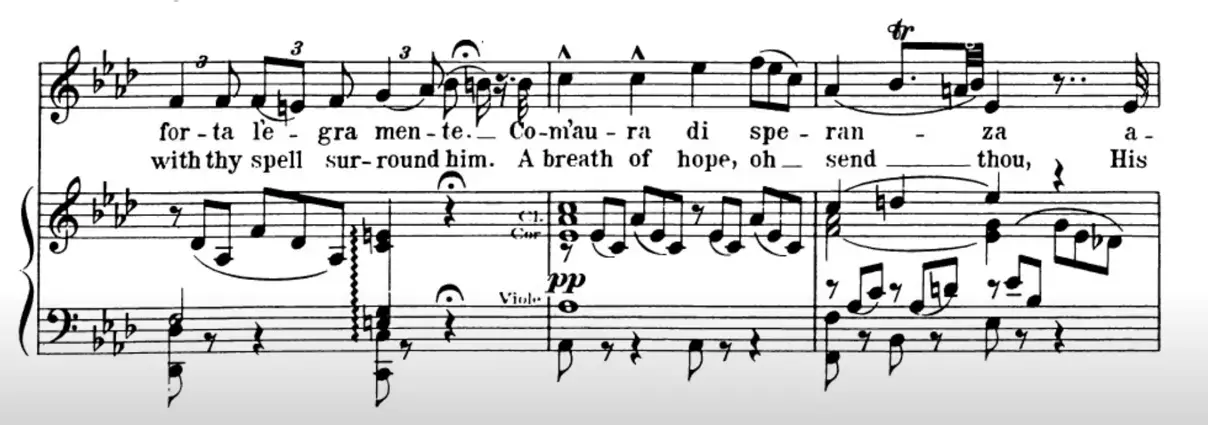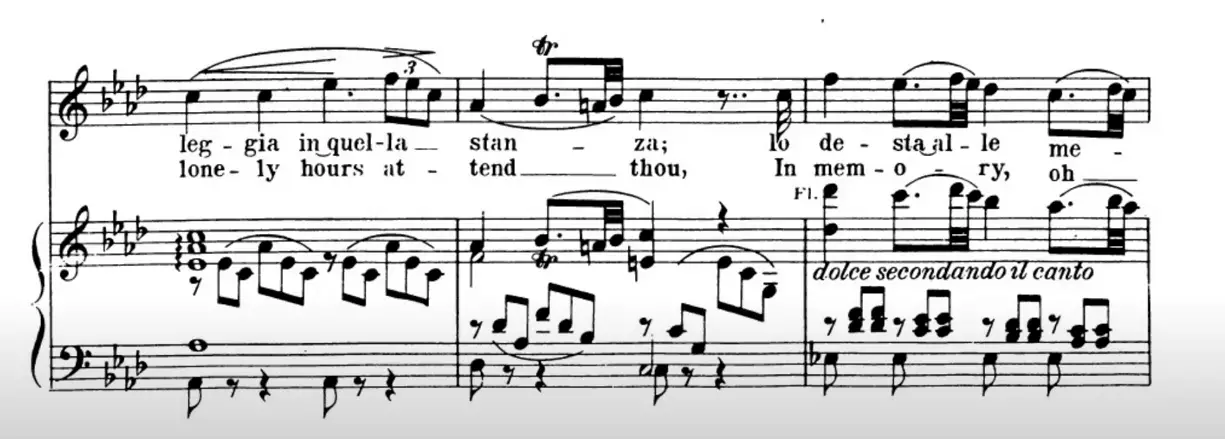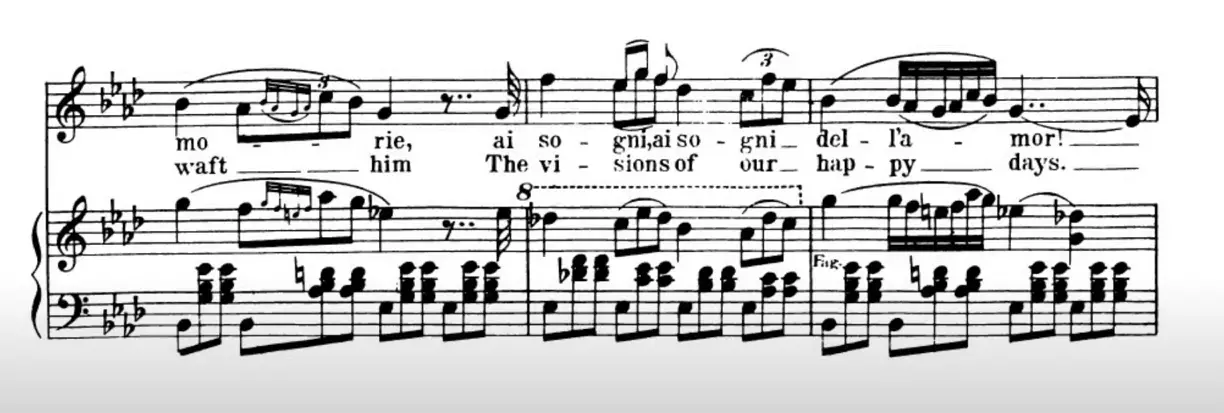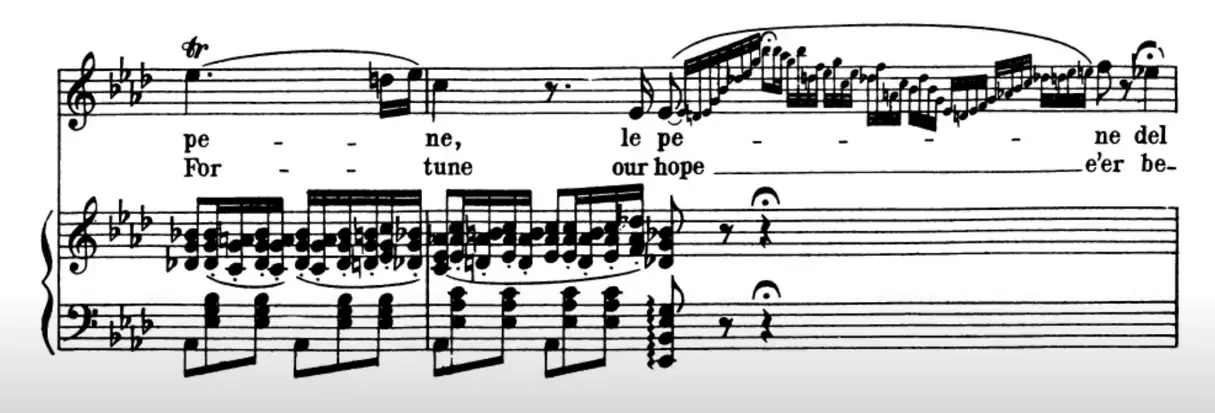The Portrait of Verdi’s Aria D’AMOR SULL’ALI ROSEE
Read Interesting facts and hear great YouTube Videos about the famous Aria “D’AMOR SULL’ALI ROSEE”.
If you want to hear more about the opera Il Trovatore, click on the link to the opera portrait
The Aria – Synopsis & Background
Synopsis: Manrico is captured and sentenced to death. Lenora visits Manrico in the dungeon and is shocked.
This scene reveals an astonishing coincidence with Beethoven’s Fidelio. Most obvious is the similarity of the names Leonore – Leonora. Moreover: as in Fidelio, the wife tries to free her husband from the dungeon. And the aria D’amor sull’alli rosee has an astonishing resemblance to Fidelio’s “Abscheulicher!… Komm Hoffnung“.
The role of Leonora demands a dramatic coloratura soprano. In this aria lyrical and coloratura skills are required. This aria must be sung with the greatest tenderness and delicacy. The aria begins adagio, accompanied by a warm, swaying rhythm of the strings.
An outstanding feature of this aria are the ornaments and trills that fall on the last notes of the verses. This gives these words great weight and the singer must convey the mood of this part of the text. In the first verse, for example, on “rosee” and in the second part the “dolente” has to be sung with great expression of pain.
After these two verses the mood brightens and with the word “Speranza” (hope) the singer brings light into the dark mood of the cell.
In the next line the singer gets the opportunity to sing a beautiful ornament on “memory”.
The final part of the aria is again held in the gloomy mood of the beginning, where Leonora recognizes the hopelessness of the situation sung as an inner dialogue. This aria is concluded with a cadenza with trills and ornaments, accompanied by the wind instruments.
The Aria – the text of D’AMOR SULL’ALI ROSEE
D’amor sull’ali rosee
Vanne, sospir dolente:
Del prigioniero misero
Conforta l’egra mente…
Com’aura di speranza
Aleggia in quella stanza:
Lo desta alle memorie,
Ai sogni dell’amor!
Ma deh! non dirgli, improvvido,
Le pene del mio cor!Afraid of me ?…sure,
ready is my defence.
His eyes are attracted by a stone
she wears on her right hand.
Wrapped in the dark
night, I am near you,
and you don’t know it…
Wailing wind,
carry to him, mercifully, my sighs…
On the rosy wings of love,
go, pained sighs:
go to alleviate the sick mind
of the wretch that lies imprisoned…
Like a breeze of hope
linger in that room:
wake him up to remembrance,
to dreams of love!
Yet do not imprudently
reveal the woes of my heart!
Vocal fach “dramatic coloratura soprano”
The role of Leonora is written for a dramatic coloratura soprano. The dramatic coloratura soprano must have both coloratura ability and the ability to master dramatic expression with a larger vocal volume. If this voice can also sing lyrical parts, so it can happen that the “dramatic coloratura soprano” can sing a wide repertoire.
Famous interpretations of D’AMOR SULL’ALI ROSEE
We hear a recording with Maria Callas. She captivates with her unique ability to transport the mood with her timbre. It is remarkable how she sings the many beautiful ornaments wonderfully natural.
D’amor sull’ali rosee (1) – Callas
A second interpretation is sung by Zinka Milanov. Her interpretation is opulent and her voice rich. Her interpretation focuses more on beauty than pain.
D’amor sull’ali rosee (2) – Milanov
A third recording with Anna Netrebko with supernatural, wonderfully soft pianissimo passages.
D’amor sull’ali rosee (3) – Netrebko
Montserrat Caballé captivates as always with the beautiful high pianissimo of her voice. While the deeper passages in the vocal are less convincing.
D’amor sull’ali rosee (4) – Caballe
Rosa Ponselle sings this aria with a beautiful legato. The voice is rich and expressive even in the high notes and has a beautiful dark timbre. She sings the moods of this aria wonderfully. e.g. the «Dolente», or the «Misero». Especially beautiful is also the final note: with great grace Ponselle floats on the final note of the cadenza.
D’amor sull’ali rosee (5) – Ponselle
An expressive interpretation of the aria “D’amor sull’ali rosee” we hear from Angela Gheorgiu. An interpretation marked by pain and agitation.
D’amor sull’ali rosee (6) – Gheorghiu
Peter Lutz, opera-inside, the online opera guide to the Aria “Tacea la notte” and “Di tale amor che dirsi” from the opera Il trovatore.









Leave a Reply
Want to join the discussion?Feel free to contribute!